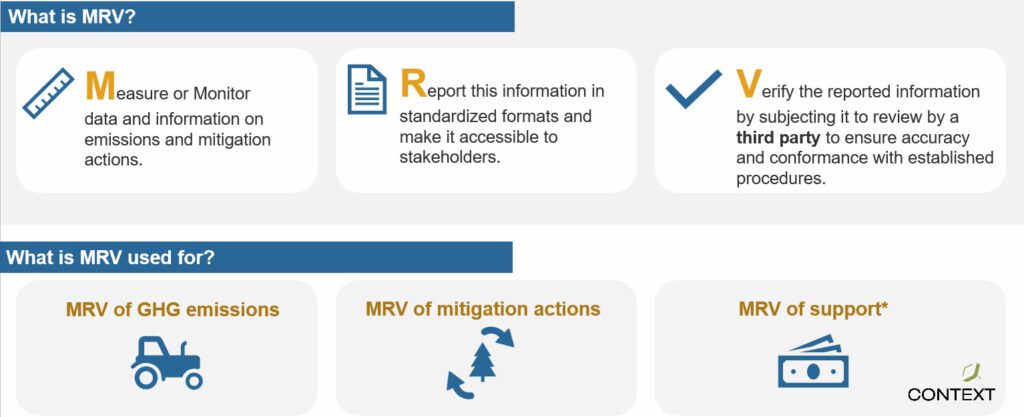How Is Soil Carbon Measured, Reported, and Verified?
Content has been adapted from the The Context Network “Get Smart, Stay Smart” Ag Carbon Service.
The short answer: Measurement, reporting, and verification is at the heart of soil carbon programs and markets—it requires accurate collection of soil data, reporting in standardized units, and third-party checks.
- Measurement of soil carbon is completed directly through soil testing and indirectly through technologies like modeling, benchmarking, remote sensing, and carbon flux.
- Reporting refers to compiling and sharing this information in standardized formats, making it accessible to stakeholders.
- Verification follows reporting, in which a third-party reviews the reported measurements to make sure they’re accurate and used proper procedures.

Figure provided by the Context Network, LLC.
Back it up: The term “MRV” refers to more than just soil carbon. It was originally coined in 2008 to help countries across the globe track and report greenhouse gas emissions, mitigation actions, and support in a clearly defined way. MRV still applies to these areas today.
- As the saying goes, “You can’t manage what you don’t measure.” MRV is key for making sure that all programs seeking to decrease emissions or mitigate CO2 are actually doing what they say they are doing.
Direct soil carbon measurement relies on a good old-fashioned soil test. Baseline measurements of soil organic carbon stocks entail taking a soil core, measuring the fine earth and coarse mineral fractions, and measuring the soil bulk density and combustion.
- But soil carbon varies across a field. To get an accurate average, you need to take a large number of soil samples.
- And to track changes over time you need to repeat the measurements in the same location over multiple years, at about the same time of year.
- Taken together, these multiple measurements and lab analyses add up—in both labor time and cost for testing.
Reporting refers to gathering measurement information in a standardized format that is easily shared between stakeholders.
- Reported measurements include soil test data, information about inputs, yield, management practices, crop rotation, and other metrics.
- In the U.S., where carbon programs are voluntary and privately operated, the specific information collected during the reporting process may vary.
- One helpful tool for reporting is USDA’s COMET-Farm tool, which gives producers a “whole farm and ranch carbon accounting tool” through the USDA’s free-to-use portal.
- Carbon programs often use their own reporting software, which can include data collection that is used for verification.
- Validation is the final step in reporting. Validation ensures that the farmer is following the processes in the protocol for the program.
Verification is the last step in the accounting process. Third-party verifiers double-check reported information to ensure it’s accurate and conforms with the procedures laid out in a specific carbon program.
- Third-party verifiers are scattered and diverse. Verification is often performed by environmental consultants like SES, Inc or SCS Global Services.
- The verification process is a method for checking the documents and files you provide to make sure that the contracted farmer did the agreed practices. It uses supporting documents to back up the practice claims.
The MRV process for soil carbon sequestration presents a number of challenges for carbon program developers, markets, scientists and farmers.
Photo by Kyle Spradley and courtesy of the University of Missouri.








